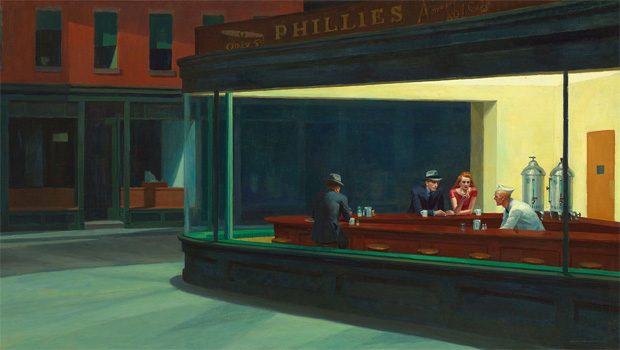The master of American simplicity
"All I wanted to do was to paint sunlight on the side of a house," Edward Hopper once said. In that quotes, he summed up a lifetime of effort in a single sentence.
At 6"5' Hopper was a towering figure of 20th century art in America. Those few words defined this taciturn man. It was light he loved best, as seen in his paintings of the Hodgkin's House in Gloucester, a woman in a bedroom and New York's Seventh Avenue on an early Sunday Morning.
A new show at Boston's Museum of Fine Arts is dedicated to Hopper's work from 1925 to 1950. It includes 100 paintings, watercolors and prints, as well as two five-and-dime ledger books, complete with his sketches, notes and prices.
Curator Carol Troyen said Hopper, who painted mundane things like the corner drug store or a lighthouse, saw painting as a way to communicate. After all, he said: "If you can say it in words you wouldn't need to paint it," she told 60 Minutes correspondent Morley Safer.
Hopper was born in 1882 in Nyack, NY, then a small prosperous town on the Hudson River. He studied at the New York School of Art and in 1906 made the first of three trips to Paris. He sold little and rarely showed his work. To make ends meet, he worked as a commercial artist, and produced hundreds of paintings and prints like one called "Night Shadows."
"It's an everyday scene," Troyen said. "You might look out your window and see this five times a night. But somehow by emptying out all the detail, hopper makes it uncanny."
Hopper lived in New York's Greenwich Village, but spent his summers on the Maine coast. He painted lighthouses as if they were monuments. In Truro on Cape Cod, he celebrated the most humble houses and inns, but it was in the fishing town of Gloucester, Mass., with its grand sea captain' houses and modest cottages, where he made his mark with "The Mansard Roof." When the Brooklyn Museum bought it in 1923 for $100, his career was launched. Clearly, he got great pleasure out of those houses.
"And we do through his eyes. But when he painted them, this was unbelievably unfashionable," Troyen said. "This was the skyscraper era. I suspect he knew that they were the kinds of buildings that people simply walked by, didn't pay much attention to."
Hopper loved rustic New England but New York City was the landscape he loved most -- the brownstones and bridges; the city's cast of characters -- a shopkeeper sitting on a sidewalk, ladies at lunch, woman in the automat, a night out at the theater and an evening in, as depicted in his painting "Room in New York."
"This is a man who's just come home from work," Troyen said while looking at the painting. "He's taken his suit jacket off. She's in an evening dress. And clearly there has been or will be or might be some disagreement about how they're going to spend the rest of the evening."
Hopper also loved painting women, especially his wife, Josephine Nivison, an artist he married in 1924, and was virtually his only model. She appears over and over again. People like Hopper. He loved the movies. By the late 1930's, familiar scenes made their way into his work, in paintings like "Nighthawks." It is his most famous work and one of the most recognizable and reproduced paintings in American art. The man sitting at the bar could be Humphrey Bogart.
"In fact, it was, because in 1939, I think, is when 'The Big Sleep' was made and he starred as Chandler's famous detective, Phillip Marlow," Troyen said.
By the time Hopper painted "Nighthawks" in 1942, he was a huge success. He had major shows at the Museum of Modem Art and the Whitney Museum and in 1956, he made the cover of Time Magazine. He was at his full strength as an artist when abstract expressionism was all the rage in American Art and he was about as far from abstract expressionism as an artist could get.
"Well, he himself was no fan of abstraction," Troyen said. "In fact, there were newspaper and magazine articles, one after another, pairing him with Jackson Pollock as the two greatest American artists of the day."
Hopper continued to paint in his later years, but produced little, only one or two pictures a year. Among them "Sun in an Empty Room," painted in 1963, four years before he died at the age of 85.
"Someone asked him when he was working on this picture what he was after in it and I can just hear him in a tone of polite exasperation saying, 'I'm after me,'" Troyen said.
Hopper was the quintessential American artist. A master of solitude and silence, capturing on canvas the '30s -- America's age of anxiety. And making the most mundane architecture -- the comer drugstore, a lighthouse, a diner -- monumental.
"It is the perception of the uncanny, the poignant, the sympathetic in the every day," Troyen said. "How he lines that up, how he makes pictures tell that story is his magic."
